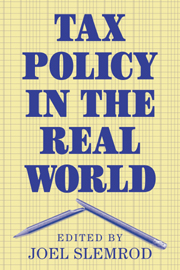Book contents
- Frontmatter
- Contents
- List of contributors
- 1 The real world of tax policy
- 2 Federal tax reform
- 3 Federalism and subfederal taxes
- 4 Principles, politics, and the professors
- Public finance in theory and practice
- On the use of ‘distribution tables’ in the tax policy process
- Taxation and economic growth
- Tax reform of the century – the Swedish experiment
- Measuring the impact of tax reform
- What is an ‘optimal’ tax system?
- How tax complexity and enforcement affect the equity and efficiency of the income tax
- Tax policy from a public choice perspective
- What is missed if we leave out collective choice in the analysis of taxation
- Public finance and public choice
- Professional opinions about tax policy: 1994 and 1934
- What can America learn from the British tax system?
- Peculiar institutions: a British perspective on tax policy in the United States
- Index
Peculiar institutions: a British perspective on tax policy in the United States
Published online by Cambridge University Press: 01 June 2010
- Frontmatter
- Contents
- List of contributors
- 1 The real world of tax policy
- 2 Federal tax reform
- 3 Federalism and subfederal taxes
- 4 Principles, politics, and the professors
- Public finance in theory and practice
- On the use of ‘distribution tables’ in the tax policy process
- Taxation and economic growth
- Tax reform of the century – the Swedish experiment
- Measuring the impact of tax reform
- What is an ‘optimal’ tax system?
- How tax complexity and enforcement affect the equity and efficiency of the income tax
- Tax policy from a public choice perspective
- What is missed if we leave out collective choice in the analysis of taxation
- Public finance and public choice
- Professional opinions about tax policy: 1994 and 1934
- What can America learn from the British tax system?
- Peculiar institutions: a British perspective on tax policy in the United States
- Index
Summary
Abstract - By both effect and example, tax policy in the United States has a huge impact on the rest of the world. This paper explores five features of the American tax system that seem, from a British and European perspective, to be both especially peculiar and potentially instructive. These are the remarkably low overall level of taxation; the absence of a value-added tax (or any other major general national tax on consumption); the absence of any explicit interstate equalization; the marginal subsidization of low earnings under the earned income tax credit; and the fragmentation of power in policymaking, an important aspect of which is the role played by the Constitution.
INTRODUCTION
The tax policy pursued by the United States has powerful effects far beyond its borders. It has a direct impact on economic activity and well-being in other countries: changes in the tax treatment of savings or investment in the United States, for example, can induce significant capital flows, while ensuring and exploiting the availability to U.S. multinationals of the foreign tax credit on their repatriated profits is a major concern for many countries in designing their corporate taxes. The U.S. tax system is also widely looked to—rightly or wrongly—as an embodiment of best practice. This is true both of the broadest elements of tax strategy—as is evident in the widespread emulation of the base-broadening, rate-cutting strategy of the 1986 Tax Reform Act—and in the most detailed matters of tax design.
- Type
- Chapter
- Information
- Tax Policy in the Real World , pp. 489 - 512Publisher: Cambridge University PressPrint publication year: 1999



